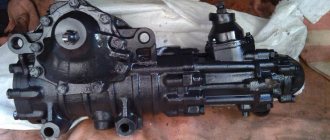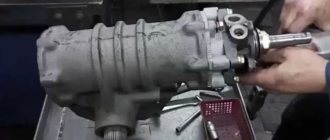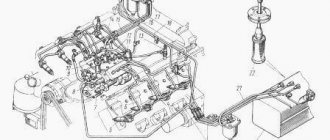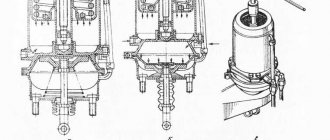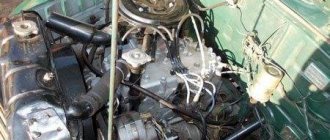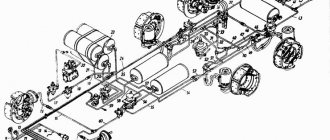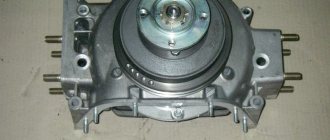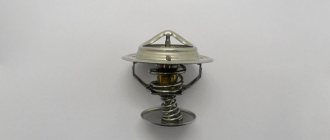Steering KamAZ 65115
Steering - with a hydraulic booster built into the steering mechanism, the working pair is a screw with a nut on circulating balls and a rack that engages with the toothed sector of the bipod shaft.
The steering wheel is located on the left; the steering mechanism is installed on the left side member of the car frame. The drive from the steering wheel to the steering mechanism is carried out via a cardan shaft with a sliding spline connection and an angular transmission with bevel gears.
The vehicles use a steering gear model 4310 with a steering gear ratio of 21.7.
The power steering pump model 4310 is a vane pump with a capacity of at least 9.0 l/min at 600 rpm and a pressure of 5500 kPa (55 kgf/cm2). The maximum pressure in the system is 8500 kPa (85 kgf/cm2). The pump drive is gear driven from the engine crankshaft.
The power steering radiator is made of finned aluminum tube, located in front of the engine cooling radiator.
On KamAZ vehicles equipped with 740.30-260 engines, it is also possible to install a steering gear model C 500 - L 115.002 (Germany) with a steering gear ratio of 21.0.
This mechanism has a valve with a rotary spool, which consists of a rotary spool operating in a worm on a needle bearing with 6 metering grooves around the circumference and a worm head located in the steering gear housing, also equipped with 6 metering grooves.
The worm and spool are drilled and pinned together with a torsion bar, which holds the metering valve in a neutral position, which corresponds to straight-line movement, until a counter force is applied to the steering wheel. If torque is transmitted from the steering wheel or steering wheels to the worm, the torsion bar is deformed and the rotary spool rotates relative to the worm head, thereby placing the metering valve in the operating position. The oil located at the metering valve enters through the now open metering grooves into one of the two cavities of the working cylinder and enhances the turning movement due to pressure on the piston surface.
The mechanism of the model C500 - L 115.002 is equipped with a hydraulic rotation limiter. This device prevents damage to the steering rods, since at the final position of the piston the adjusting screw rests against the limit valve, which allows oil to drain. In this case, the hydraulic force is significantly reduced, and the steering wheel can be turned all the way only with additional effort.
The cylindrical spur gearing of the piston and the bipod shaft has a high surface finish, so the wear of both gears is extremely small, which makes it possible to reduce maintenance of the steering mechanism to a minimum. The gearing of the bipod shaft in its middle position has no clearance.
The RBL model P1617 power steering pump is a vane pump with a capacity of at least 9.0 l/min at 600 min-1 and a pressure of 7000 kPa (70 kgf/cm2). The maximum pressure in the system is 15000 kPa (150 kgf/cm2). The pump drive is gear driven from the engine crankshaft.
The pump reservoir is equipped with a paper filter and an oil level indicator, mounted on the engine on an additional bracket. The paper filter must be changed as it becomes dirty, at least every 100 thousand kilometers.
Removing air from the hydraulic system (bleeding) is carried out with the longitudinal link disconnected from the bipod in the following order:
For steering gear model 4310 (without self-bleeding):
- remove the pump reservoir cap;
- remove the protective cap from the bypass valve (see figure Power Steering) and put on the elastic hose. Place the open end of the hose in a glass vessel with a capacity of at least 0.5 liters, half filled with oil;
- unscrew the steering gear bypass valve ½—¾ turn;
- turn the steering wheel to the left all the way;
- pour oil into the pump reservoir until its level stops decreasing;
- start the engine and, while operating at a minimum crankshaft speed, add oil to the pump reservoir, not allowing its level to drop, until the release of air bubbles from the hose in the container stops;
- close the bypass valve;
- turn the steering wheel to the right until the force begins to increase and return it to the left position again, open the bypass valve and watch for the release of air;
- repeat the previous operation until clean oil (without air bubbles) comes out of the hose. Constantly monitor the oil level in the pump reservoir, making sure it does not drop.
For model 4310 steering gear:
- remove the pump reservoir cap;
- remove the protective cap from the bypass valve (see figure Power Steering) and put on the elastic hose. Place the open end of the hose in a glass vessel with a capacity of at least 0.5 liters, half filled with oil;
- unscrew the steering gear bypass valve ½—¾ turn;
- turn the steering wheel to the left all the way;
- pour oil into the pump reservoir until its level stops decreasing;
- start the engine and, while operating at a minimum crankshaft speed, add oil to the pump reservoir, not allowing its level to drop, until the release of air bubbles from the hose in the container stops;
- close the bypass valve;
- turn the steering wheel to the right until the force begins to increase and return it to the left position again, open the bypass valve and watch for the release of air;
- repeat the previous operation until clean oil (without air bubbles) comes out of the hose. Constantly monitor the oil level in the pump reservoir, making sure it does not drop.
If air cannot be removed, check the tightness of the connections of the hydraulic system and the joints of the parts, rinse the filter of the power steering pump.
For the steering mechanism model C500 - L 115.002, turn the steering wheel to the right until the force begins to increase and return it to the left position again, repeat this cycle at least three times. Then add oil to the pump reservoir.
If air cannot be removed from the steering system, check the tightness of the hydraulic system connections and the joints of the parts, and wash the power steering pump filter.
Check the oil level in the power steering pump reservoir with the engine idling and the front wheels of the car set straight.
The normal level for the steering mechanism of the model 4310 should be between the marks on the indicator (see Fig. Checking the oil level in the power steering pump reservoir), mounted in the filler neck of the reservoir; for the mechanism model C500-L 115/002 - between the MIN and MAX marks on the reservoir body (see Fig. Checking the oil level in the reservoir of the power steering pump model P1617 from RBL). Checking the oil level in the tank is done with a pointer mounted in the tank lid.
Design and principle of operation of power steering KamAZ-5320 (power steering)
The KamAZ-5320 vehicle uses mechanical steering with hydraulic power steering (power steering). Power steering 53212-3400020 is designed to reduce the force required to rotate the steering wheel when turning the front wheels, to soften the shock that occurs when traveling on uneven roads, and also to improve driving safety due to the ability to control direction when a front tire tire breaks. car. The steering mechanism is equipped with a gear-type angular reducer; the steering gear includes working pairs of the screw-nut type with circulating balls and a gear sector-rack.
The operation of the KamAZ hydraulic booster (power steering) occurs with constant fluid circulation, which ensures a reduction in the pump load. The system fluid pressure is 7500-8000 kPa (max). The amplifier cylinder is mounted in the steering gear housing. The control valve is of the spool type, equipped with reaction plungers and centering springs that create a feeling of resistance when turning the wheels.
Attention! When the hydraulic booster 53212-3400020 is turned off, the steering mechanism still ensures that the wheels turn, but at the same time the components and parts are exposed to full loads. In order to avoid premature wear and possible breakdowns of parts of mechanisms during long-term operation of the vehicle (including its towing) with an inoperative hydraulic booster, the driving time of the vehicle should be minimized if possible.
Inspection and identification of defects
Carefully inspect the contents and remember (you can take a photo) what was placed where and how (more attention should be paid to the position of the cylinder). You can twist the power steering pulley and carefully use tweezers to check how the blades move in the grooves of the shaft
All parts should be pulled out without effort, since they do not have any fixations, but the central axis is firmly fixed and cannot be removed.
We inspect the shaft from the reverse side, parts (power steering housing and cover wall) touching them, for burrs or grooves, everything is perfect for me.
Now we remove the entire internal economy onto “clean” rags and begin to study it.
We carefully examine the shaft; all its grooves have very sharp edges on all sides. One of the end sides of each groove has a pronounced sharpness inward, which, when moving the blade inside the groove with a constant slope towards this side, will greatly complicate its movement (this may be the first component of poor power steering performance). The side parts of the shaft grooves are also “sharpened”; this can be felt if you run your finger in different directions along the end (outer circumference), as well as along the side parts of the shaft in different directions. Otherwise the shaft is perfect, has no flaws or nicks.
Rice. 1 — Diagram of the power steering of the KamAZ-5320 car
1 – steering wheel; 2 – steering column; 3 – cardan shaft; 4 – centering spring; 5 – jet plunger; 6 – thrust bearing; 7 – spool; 8 – power steering control valve; 9 – safety valve of the steering mechanism; 10 – longitudinal thrust; 11 – steering gear housing; 12 – screw; 13 – ball nut; 14 – magnetic plug; 15 – longitudinal thrust; 16 – bipod; 17 – piston-rack; 18 – rear cavity of the hydraulic booster; 19 – bipod shaft with a gear sector; 20 – bypass valve; 21 – power steering pump; 22 – discharge line; 23 – front cavity of the hydraulic booster; 24 – angular gearbox; 25 – drain line; 26 – pump reservoir; 27 – filling filter; 28 – hydraulic system filter safety valve spring; 29 – filter; 30 – bypass valve spring; 31 – pump safety valve; 32 – bypass valve; 33 – transverse thrust; 34 – car front wheel; 35 – radiator; A and B – throttling holes; I – straight movement or neutral position; II – turn left; III – turn right.
Attention before operating KamAZ power steering is required:
The inlet filter and filtration element are washed, and if they are significantly clogged with resinous deposits, they are additionally treated with a special solvent. When carrying out seasonal maintenance (in the fall), the oil in the KamAZ-5320 (Classic) power steering must be completely replaced.
1. Air remaining in the KamAZ power steering leads to rapid breakdown of the pump and damage to parts of the steering mechanism. The presence of air in the system or its entry is indicated by foaming oil in the pump reservoir, external leaks and clogging of the system, and loud noise of the pump. Also, if after stopping the engine, the oil level in the tank rises 10 mm or more, air remains or gets in the power steering hydraulic system. To avoid pump failure, it is necessary to eliminate the presence of air in the system or eliminate the presence of air entering the system.
2. Sealing the KamAZ power steering after replacing the steering mechanism: a) raise the front wheels of the car so that they come off the ground; b) add fluid, turn the steering wheel from end to end 20 times and add fluid again; c) start the engine for 2 seconds and turn it off, add fluid; d) start the engine again for 3-4 seconds. And turn it off, add fluid again (if necessary); e) start the engine, check the oil level in the tank, turn the steering wheel in one direction and then in the other; f) lower the front wheels of the car; g) turn the steering wheel in one direction and release air from the power steering breather (located under the power steering bipod shaft), then turn the steering wheel in the opposite direction until it stops and release air from the power steering breather again. The sealing of the KamAZ power steering system has been completed, and sea trials can be carried out.
Signs of typical element malfunctions
If you need to constantly level the car using the steering wheel while driving, then you need to check for free play in the steering wheel. If it is higher than necessary, the stroke should be adjusted. You also need to make sure and check whether the parts of the screw pair are worn out.
If air gets into the hydraulics, foamy and cloudy liquid can be seen in the reservoir. In this case, you need to flush and bleed the systems. The filter also needs to be replaced. In addition, one of the typical faults is the manifold gasket, which can wear out.
We repair and adjust the power steering on a KAMAZ with our own hands
The hydraulic steering control system is an integral part of any KAMAZ, since without it, steering the vehicle will be, if not impossible, then very difficult. Thanks to this unit, the driver can turn the steering wheel with greater ease. You can learn more about what the KAMAZ power steering system is and how to de-air it from this material.
Green liquids
This is already Pentosin. In fact, one of the leading brands on the market and I would recommend it.
The danger is that the Pentosin mixture can come in the form of synthetics and in the form of a classic green mineral water. Therefore, you should be as careful as possible here. This oil is recommended for use in Kamaz trucks.
Accordingly, we can conclude that Pentosin and Dextron oils, in essence, for automotive power steering are simple factory mixtures with low viscosity.
The main thing to consider when mixing them with each other or when replacing these oils is the composition and its type (synthetic oil or mineral).
So much for steering autocolors.
Characteristics of power steering
First, let's look at the main characteristics of the power steering on a KAMAZ 6520 or any other model. Let's start with the purpose and device.
Purpose
The main purpose of the power steering system is to minimize the effort used to turn the steering wheel when steering, as well as performing many maneuvers when driving at low speeds. In addition, thanks to the power steering system, the impact on the steering wheel will be more noticeable if the car is moving at high speed. If the power steering fails for some reason, this will result in the driver having to exert significantly more effort to turn the steering wheel.
General diagram of the KAMAZ steering control operation
Device
Now let's briefly look at the power steering device.
This system consists of the following elements:
- Switchgear. This component is used to direct the flow of working fluids, in particular hydraulic oil, into the lines and cavities of the system.
- Hydraulic cylinder. This device performs the function of converting hydraulic pressure into mechanical work of pistons and rods.
- The working material in this case is hydraulic fluid. With its help, force is transferred from the pump to the hydraulic cylinder. In addition, thanks to the liquid, all rubbing components and components of the system are lubricated.
- KAMAZ power steering pump. Thanks to this device, the pressure required for normal operation is constantly maintained in the system. This element is also used to circulate the working fluid.
- Connecting elements or lines. They are used to bring together all the working components of the system.
- Control device or electronic unit. With its help, direction and adjustment of the operation of the amplifier are carried out.
Photo gallery “Main elements of the power steering system”
Features of the pump
The pumping device is installed in the collapse of the BC. Domestic trucks use a gear top drive, but the device itself is of the blade type. In accordance with the technical documentation, this unit is characterized by double action, that is, with one turn of the steering wheel it carries out two cycles of suction and discharge.
Let's take a brief look at the operating principle. When the wheel turns, the rotor blades begin to rotate, which, in turn, are pressed against the stator device. Working fluid begins to flow into those blades that, when pressed, coincide with the holes on the body. Further, thanks to the same blades, the consumable material enters the narrower holes that exist between the stator and the rotor.
At the moment when the working surfaces can coincide with the holes on the distribution disk, the consumable material will come out beyond it. Next, the oil will pass through the lower valve; for this, high pressure is formed in the system.
The working fluid, leaving the cavity behind the distribution disk, will flow onto the rotor blades, as a result of which they will be pressed even more tightly against the stator plane. The process of pumping the substance, as well as its absorption, is carried out simultaneously in two places. As the number of revolutions of the rotor device increases, liquid from the surface behind the disk will not pass through the calibration hole. By creating pressure in the system, the bypass valve is opened, and part of the consumable material, through the manifold, is again supplied to the suction surface (the author of the video about replacing the hydraulic booster on a KAMAZ is Mathur Malay).
Principle of operation
By turning the wheels of KamAZ-5410 and others, the rotor blades perform rotational movements and are adjacent to the stator. The parts that coincide with each other form passages into which lubricant is supplied and passes further due to the resulting pressure. The formed pressure pushes the liquid through the lower valve due to the fact that the oil, at the moment the passages of the distribution disk and the surface coincide, goes beyond the products.
Power steering pump KamAZ-65116, etc.:
The oil enters the rotor blades, having previously passed through the distribution disk. Due to the pressure, the blades adhere more strongly to the stator. The inlet and injection of liquid occurs simultaneously in two directions. An increase in rotor speed prevents the passage of lubricant through a calibrated hole from the area located behind the disk. The resulting pressure acts on the bypass valve, forcing it to open. As a result of valve activation, part of the working fluid passes through the manifold and again enters the suction surface.
Common power steering faults
It must be said right away that repairing KAMAZ power steering is a procedure that our compatriots do not encounter so often. If the driver follows the basic rules for operating the unit, and also carries out its maintenance in a timely manner, then the likelihood that it will fail will be minimized. As practice shows, problems with the performance of the hydraulic booster mainly arise in the cold season. In general, all malfunctions can be divided into mechanical and hydraulic failures, both of which can occur in any part of the device.
As you know, any hydraulic system most often exhibits malfunctions in frosty conditions, in particular, temperature changes. After all, you need to remember that the pumping device pumps high pressure, so if the viscosity of the liquid in the system increases, this will lead to the squeezing out of the seals and, accordingly, its leakage. The problem of oil seals is especially evident in cars whose drivers do not follow operating rules, for example, leaving the car in a parking lot with the wheels twisted. This will lead to the fact that after starting the engine, the pressure will increase only on one side, accordingly, the oil seal will squeeze out in any case.
As for the warm season, in summer malfunctions usually appear as a result of dirt and dust getting into the system. If any part is depressurized, the wear of the bushings, as well as the rods, will be faster. Rods usually rust quite quickly, resulting in accelerated wear of the bushings. When operating a car with such a problem, after several hundred kilometers, there will be a large gap between these elements, and this, in turn, will lead to the steering rack starting to make a knock (author of a video about repairing the system in a garage - channel EIGHT ATMOSPHERE).
About the most typical failures that are inherent in power steering
It must be said that Kamaz power steering malfunctions occur infrequently. With high-quality operation and timely maintenance of this unit, you can forget even about frequent adjustments. However, although infrequently, you can read about problems with the amplifier.
If it weren’t for the Russian winter, then the power steering would have worked the entire time the truck was in use. However, winter frosts and terrible roads often lead to too early wear of the power steering mechanisms. Typically, all breakdowns can be divided into mechanical problems and hydraulic faults.
Both mechanical and hydraulic problems can appear in any part of the assembly. Like any hydraulic system, the amplifier does not tolerate cold. He especially doesn't like too drastic changes. The same pump pumps out quite a lot of pressure. Consequently, if the viscosity of the working oil suddenly increases, the seals may be squeezed out.
In addition, it is not always possible to follow even the simplest rules of safe use. Drivers often leave their cars with their wheels turned out in extreme cold. After the engine is started, the pressure will increase on only one side. As a result, the seal will squeeze out. Also, few people replace hydraulic fluid according to regulations. And it can thicken over time. This leads to unnecessary pressure.
But this is winter, what about summer? But here problems arise mainly due to dust or dirt. Only a very slight depressurization of the system is enough, and the KamAZ power steering will soon need to be repaired. So, when depressurizing, the rods and bushings wear out. The former immediately rust and increase wear on the latter. After a couple of hundred kilometers, the gaps between the rod and bushing will become larger than permissible. So, the steering rack will knock.
How to remove an air lock from the system?
The need to bleed the system usually arises after refueling it or eliminating breakdowns in the operation of the unit. Air entering the lines leads to less efficient operation of the hydraulic booster, so the only solution in this case is to remove the air.
So, how to bleed the power steering:
- First you need to move the front axle so that the car's wheels do not touch the ground. Using a jack, you should place supports under the beam on both sides. If the wheels are on the ground, bleeding of the system cannot be started.
- Then you need to remove the filler cap of the expansion tank located under the hood.
- Next, the rubberized cap should be removed from the bypass valve, and an elastic pipe should be installed on its head. In this case, its open part should be lowered into a glass container, the volume of which will be at least half a liter. The vessel itself should be filled halfway with the working fluid.
- Then the bypass valve should be opened slightly, half a turn.
- After completing these steps, turn the steering wheel to the left all the way. After this, the working fluid is poured into the expansion tank until its level decreases.
- Then you need to start the power unit, and while it is operating at minimum speed, pour a little liquid into the expansion tank, but without allowing the level to drop. Do this until bubbles stop coming out of the pipe that is installed on the bypass valve. After this, the valve itself can be closed.
- Next, the steering wheel should be turned all the way to the right, and then to the left. And holding the steering wheel in this position, again unscrew the bypass valve halfway and observe whether bubbles come out of the pipe. When they stop coming out, the valve can be tightened.
- This operation must be carried out several times, ultimately a clear liquid will come out of the valve, in which any impurities or air bubbles should be absent. If bubbles continue to come out, the procedure should be repeated several more times, but do not forget to monitor the volume of working material in the expansion tank.
- Then all you have to do is turn off the motor and remove the pipe from the valve head. Put the cap on the head itself, and then again diagnose the volume of liquid in the tank. If there is a need, it will need to be added. Further assembly of all components is carried out in reverse order.
Checking and adjusting power steering KAMAZ
Checking and adjusting the backlash of the KAMAZ power steering must be carried out when the engine is turned off. The steering linkage should also be disengaged. Actions taken during this process:
- wheel balancing and air pressure levels inside the wheels are checked;
- steering rods, wheel bearings are inspected, shock absorbers are checked;
- the oil content inside the pump reservoir is checked - the presence of air is unacceptable, oil leaks and sediment are also not allowed.
How to check KAMAZ power steering
First, it is necessary to evaluate the condition of the wheel balancing, the air pressure inside the tires, the adjustment of the wheel bearings, and the functioning of the shock absorbers.
Be sure to check the oil content inside the pump reservoir. You need to make sure that there is no air or dirt inside. The absence of oil leaks is also checked.
The force of the steering wheel is measured by a dynamometer attached to the wheel rim in three options relative to the position of the latter:
- When the steering wheel is turned more than two turns compared to the middle position, the force on it should be from 5.9 to 15.7 newtons. In this situation, the engagement with the ball screw is located in a position that is close to the extreme, with almost complete exclusion of friction, and the magnitude of the force is determined mainly through the friction moment of the bearings for the stop and the power steering seals. When the wheel rim force does not match the specified value, this indicates that the screw bearings are incorrectly (too tightly or too loosely) tightened or indicates damage to the ball nut. If the tightening is insufficient, the vehicle's directional stability deteriorates, and if it is over-tightened, in addition to damaging the ball nut, the steering mechanism jams.
- When the said wheel is turned three-quarters of a turn from its center position, the force must not exceed 22.6 and not be less than 19.6 newtons. In this position, friction occurs in the ball screw and is caused by preload. In the case when the force deviates from the above figures, damage to this pair can be stated.
- When this wheel is located in the middle position, the force on it should be 3.9-5.9 newtons higher than the force that is obtained if measured in the 2nd position described above, but should also not exceed 21.8 newtons. In such a situation, the power steering engagement adjustment is checked. When the force is insufficient compared to the above value, the clearance in the engagement exceeds the permissible level, and when it exceeds this value, this indicates that the clutch is over-tightened, which leads, among many reasons, to unsatisfactory self-return of the wheels to the center position. When the forces in the above positions do not correspond to the described values, the hydraulic booster should be adjusted.
Adjusting pressure in KAMAZ power steering
It is necessary to begin this operation by determining the force in the 3rd of the above positions. Using the adjusting screw, you need to bring the force back to normal. When this screw rotates in a clockwise direction, the force increases and vice versa.
To adjust the force in the 1st position, it is necessary to partially disassemble the steering mechanism to tighten or loosen the nut used to secure the bearings. To eliminate the factors causing the force to not correspond to the norm in the 2nd position, it is necessary to completely disassemble the power steering.
When checking the pressure in the power steering in the section of the pressure line located between the steering mechanism and the pump, you should use a device that includes a pressure gauge whose scale reaches 9810 kPa, as well as a valve that stops the flow of oil to the power steering.
When checking the pressure, you need to open the valve, then turn the steering wheel to the stop position and apply at least 98.1 Newtons to it. The oil pressure when the crankshaft rotates at 600 rpm must be a minimum of 7355 kPa.
When the oil pressure is less than 7355 kPa, slowly close the valve while monitoring the level of pressure increase using a pressure gauge. When the pump is in good condition, it should increase to a minimum of 8336 kPa.


